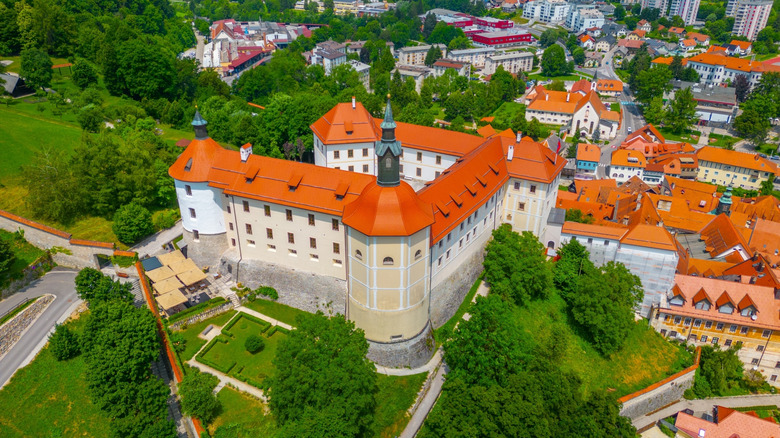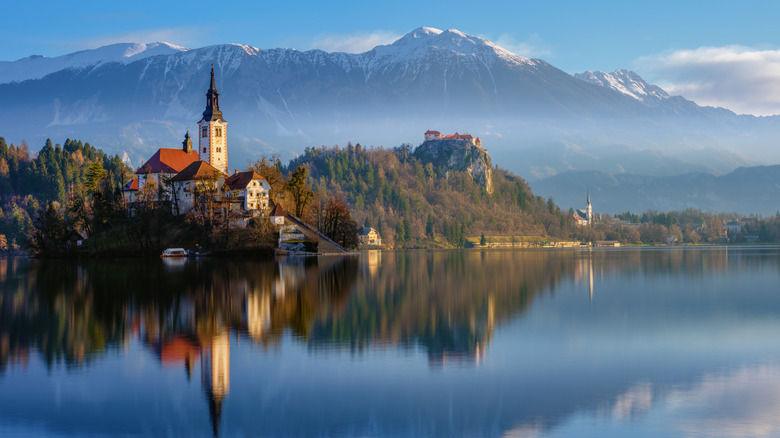A Charming Slovenian Town Is The Gateway To A Magical Realm Of Castles And Mansions In The Julian Alps
Nestled in Slovenia's Upper Carniola Region is a town where time seems to have stopped. Surrounded by pristine nature and crossed by the Sora River, Skofja Loka is a historic town located about 15 miles from the capital, Ljubljana. Founded in the 11th century, it's the most-preserved medieval town in the country and home to renowned castles and mansions, which are set against the backdrop of the Julian Alps Mountain Range.
Known as a walled city, the Skofjia Loka's fortifications fell out of use and were largely taken down, including the gates, by 1789. Once inhabited by talented artisans, the old town still conserves its ancient atmosphere, evoking the charm of centuries gone by. Stroll along Skofjia Loka's streets and you'll reach the Capuchin Bridge, a half-moon-shaped stone structure flanked by old houses along the riverbank, reminiscent of one of Italy's most underrated mountain towns, Merano.
Perched on a hill overlooking the town, the Skofja Loka Castle is the region's most important attraction. It looks out over two main squares: the upper Mestni Trg and the lower Spodnji Trg. First established in 1202 by the Freisings of Skofja, the castle was almost destroyed by the 1511 earthquake and was later rebuilt under Bishop Filip. Although the original four-cornered tower is missing, its layout has been accurately reconstructed. Today, the castle is home to one of Slovenia's most curated museums, the Loka Museum, which showcases collections of ancient artifacts, natural history, and ethnography. In the castle garden, you'll also find an outdoor museum with relocated structures from the village of Pustal, including the Skopar House — a beautifully maintained farmhouse dating back to the 1500s. The castle should not be mistaken with the historic Old Loka Castle, built during the 1400s and recognized as a national treasure.
Castles and mansions in Skofja Loka
Home to several fortresses, Skofja Loka features medieval castles that look like they've stepped out of a fairytale, and it's no surprise that Slovenia offers a European road trip featuring seven fairytale castles all connected in one inspiring route. Established between the 13th and 17th centuries, the manors were built throughout different parts of the region, with some now housing museums. The town of Skofja Loka is also famous for its Three Castle Path, but unfortunately, the castles were wiped out during the earthquake. Among the triad, only Loka Castle was reconstructed, but ruins remain of both Wild Loka Castle and the Tower of Krancelj. Wild Loka was constructed in the 12th century and is nestled in the forest below Lubnik, while the Tower of Krancelj dates back earlier, once featuring fortified structures typical of the medieval period in Central Europe.
Dating back to 1220, Puštal Castle is a Renaissance mansion that currently serves as home to the Skofja Loka Music School. Inside the castle chapel, a fresco painted in 1706 is considered one of Skofja Loka's most prized artworks. Homan's House stands out as one of Skofja Loka's most notable historical landmarks. Originally constructed in the Gothic style, it was later enriched with Renaissance features following the 1511 earthquake. Established during the 17th century, the German Renaissance-style Ajman Castle was ravaged by flames during World War II and later restored by Ursulines (a group of religious women) and converted into a convent. A work by Franc Jelovsek, Slovenia's most prominent Baroque fresco artist, can still be seen inside.
Throughout history, Slovenia has regarded painting as a key form of artistic expression, with many historic houses transformed into art galleries that showcase the region's artistic legacy. An example is Subic's House, which was once home to a family of painters and now serves as a museum showcasing artworks by various artists. Grohar's House exposes the works of Impressionist artist Ivan Grohar, alongside a collection of cultural artifacts used by local makers and farmers.
Outdoor adventures in the Julian Alps
Ljubljana is the closest city to Skofja Loka and its surroundings. The medieval town is just a 30-minute drive from Ljubljana Jože Pučnik Airport, and the bus ride takes roughly the same amount of time. It takes about 2.5 hours to drive from Skofja Loka to the Julian Alps, where a sense of peace and stillness lingers in the air as towering summits mirror themselves in the region's lakes, surrounded by flourishing greenery. Named in honor of Julius Caesar, the Julian Alps are a mountain range spanning Italy and Slovenia, with Mount Triglav as its highest peak, rising to 9,395 feet above sea level. Slovenia's Alpine region boasts wide areas for relaxing and exciting outdoor activities, including Europe's long-distance mountain trail dotted with charming inns.
Many cycling activities can get you to explore the region at a slower, yet challenging pace. The famous Juliana Bike Route is a 180-mile path passing through mountain villages, piney lowlands, and alpine lakes like Bled and Bohinj. The terrain is mainly asphalted, but for the more adventurous, the trail also offers off-road tracks for mountain biking. Do not forget to visit Isonzo Valley, just below Mount Triglav, and the Cerkno region.
Hiking is very popular in Slovenia, and the Alpe Adria Trail is a route that links three countries (Slovenia, Italy, and Austria), passing through glaciers and along the Adriatic shoreline. As thrilling as it sounds, preparation is key before embarking on this adventure. As the famous local saying goes: "The mountain isn't crazy, the person climbing it is." For watersports enthusiasts, canoeing and rafting are among Skofja Loka's outdoor activities. Bled, located about a 40-minute drive from Skofja Loka, offers plenty of opportunities for paddling and whitewater adventures. It is a must-see, picturesque location featuring a lake with a church-topped island at its center.


